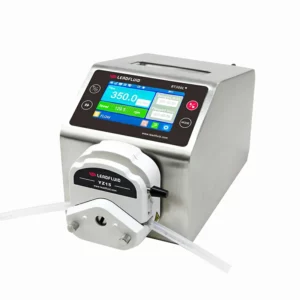A pump’s flow rate refers to the volume of fluid that it can move per unit of time. The flow rate is a crucial parameter in pump selection and is determined by the pump’s design, specifications, and operating conditions.
Here are some common applications and uses of pumps based on their flow rate:
- Water Supply and Distribution: Pumps with higher flow rates are commonly used in water supply and distribution systems. They are employed to transport water from sources such as wells, reservoirs, or treatment plants to residential, commercial, and industrial areas.
- Irrigation: Pumps with moderate to high flow rates are used in agricultural irrigation systems to deliver water to crops, fields, or orchards. These pumps ensure that an adequate volume of water is supplied to meet the irrigation needs of plants.
- Industrial Processes: In various industrial applications, pumps with specific flow rates are utilized. For example, in chemical processing, pumps are used to transfer fluids between storage tanks, mixers, reactors, and other equipment. In manufacturing processes, pumps are employed for material handling, cooling, lubrication, and circulation.
- Wastewater Treatment: Wastewater treatment plants use pumps to move wastewater through various treatment stages. Pumps with appropriate flow rates facilitate the transport of sewage, effluent, or sludge for processes such as screening, sedimentation, aeration, and disinfection.
- Oil and Gas Industry: Pumps with high flow rates are essential in the oil and gas industry for tasks such as crude oil extraction, pipeline transportation, and refinery processes. These pumps handle large volumes of fluids, including oil, gas, and various petroleum products.
- Mining Operations: Pumps play a crucial role in mining operations, where they are used to dewater mines, transport slurry, and remove excess water from excavation sites. Pumps with varying flow rates are selected based on the specific requirements of the mining process.
- Fire Protection Systems: High-flow pumps are essential components of fire protection systems in buildings, industrial facilities, and public spaces. They ensure the delivery of water at sufficient flow rates for firefighting purposes.
These are just a few examples of the diverse applications for pumps based on their flow rates. The specific flow rate requirements depend on the intended use, flow rate pump the characteristics of the fluid being pumped, and the system’s design parameters. It’s important to select a pump with an appropriate flow rate to ensure efficient and reliable fluid transfer in the desired application.
Here is some additional information about the use of pumps based on flow rates:
- Municipal Water Treatment: Pumps are used in municipal water treatment plants to move water through various treatment processes, including filtration, disinfection, and chemical dosing. Different pumps with specific flow rates are employed at different stages to ensure efficient water treatment and distribution to consumers.
- HVAC Systems: Heating, ventilation, and air conditioning (HVAC) systems utilize pumps to circulate water or refrigerant through the system. Pumps with appropriate flow rates are employed to ensure efficient heat transfer, maintaining comfortable indoor temperatures and facilitating the exchange of heat between the HVAC system and the surrounding environment.
- Pharmaceutical and Biotechnology: In pharmaceutical and biotechnology industries, pumps with precise flow rates are used for drug formulation, liquid dispensing, and bioprocessing applications. These pumps ensure accurate and controlled delivery of liquids and chemicals in research laboratories and manufacturing processes.
- Food and Beverage Processing: Pumps play a crucial role in the food and beverage industry for fluid transfer, mixing, and filling operations. They are used to transport ingredients, transfer liquids between processing stages, and fill containers with precise volumes. Pumps with specific flow rates help maintain consistency in production processes and ensure accurate dosing.
- Marine and Offshore Applications: Pumps are utilized in marine and offshore industries for various purposes, such as ballasting and bilge pumping, fuel transfer, and fire suppression systems. The flow rates of these pumps depend on the specific requirements of the marine application, vessel size, and operational conditions.
- Power Generation: Power plants, including thermal, nuclear, and hydropower facilities, employ pumps for water circulation, cooling, and condenser systems. Pumps with varying flow rates are used to meet the specific needs of each power generation process.
- Construction and Dewatering: Pumps with high flow rates are commonly used in construction projects for dewatering excavations, tunnels, and construction sites. They help remove accumulated water, allowing for safe and efficient construction activities.
- Aquaculture and Fish Farming: Pumps are utilized in aquaculture and fish farming operations to circulate water, maintain oxygen levels, and filter water in fish tanks or ponds. The flow rates of these pumps are crucial for maintaining optimal water quality and ensuring the well-being of aquatic organisms.
These examples demonstrate the wide range of applications where pumps with specific flow rates are essential. The choice of pump depends on factors such as the desired flow rate, fluid properties, system requirements, and the environment in which the pump will be used. It is important to select a pump that matches the flow rate requirements of the specific application to achieve efficient and reliable fluid handling.
